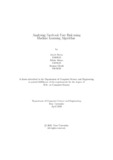| dc.contributor.advisor | Arif, Hossain | |
| dc.contributor.advisor | Islam, Md. Saiful | |
| dc.contributor.author | Barua, Arnab | |
| dc.contributor.author | Adnan, Fahim | |
| dc.contributor.author | Ghosh, Ananna | |
| dc.date.accessioned | 2021-05-29T16:05:45Z | |
| dc.date.available | 2021-05-29T16:05:45Z | |
| dc.date.copyright | 2020 | |
| dc.date.issued | 2020-04 | |
| dc.identifier.other | ID: 15301012 | |
| dc.identifier.other | ID: 15101023 | |
| dc.identifier.other | ID: 19141020 | |
| dc.identifier.uri | http://dspace.bracu.ac.bd/xmlui/handle/10361/14447 | |
| dc.description | This thesis is submitted in partial fulfillment of the requirements for the degree of Bachelor of Science in Computer Science and Engineering, 2020. | en_US |
| dc.description | Cataloged from PDF version of thesis. | |
| dc.description | Includes bibliographical references (pages 40-42). | |
| dc.description.abstract | Now-a-days people exchange their personal information and interact with companions and close relatives in a way which is revolutionized. In any case, the majority of
them don’t have the foggiest idea how to utilize, where to click, where not to, where
to remark, and where not to. A considerable lot of them are posting in Facebook
anything they desire and wish. This posting, fellowship and so on once in a while
brings shocking occasions like identity theft, phishing, Cyber-wrongdoing and so
on. So, Social media security has captured a great concern among the public and
authority. At present, many features have been added to reduce the risk of hacking
information. It is widely acknowledged that these features have played an important role in the security system. The essential focus point of our paper is on the
safety implications of consumers posting their own Facebook information. We have
made a survey containing 44 inquiries dependent on Facebook clients’ propensity
and different things. We have looked at the ongoing information security rupture
on Facebook through certain data mining substances. We have targeted three questions about victim of malware, identity theft, and phishing. From, our dataset we
will know how many were victim of the three target parameter. We have implemented machine learning algorithms like ANN, XGBoost, SVM, Random Forest,
Decision Tree, Gaussian Naive Bayes, Logistic Regression to identify the percentage
of how many Facebook accounts are in risk and safe. Moreover, we will compare the
best possible approach and worst approach among the algorithms to find the result.
Among the models, we see ANN providing us the best result for the three labels
with 89.89%, 94.94% and 86.86%. This research illustrates how different machine
learning algorithms predicts the risk of Facebook users and which algorithm is most
and least suitable to use in this scenario. | en_US |
| dc.description.statementofresponsibility | Arnab Barua | |
| dc.description.statementofresponsibility | Fahim Adnan | |
| dc.description.statementofresponsibility | Ananna Ghosh | |
| dc.format.extent | 42 pages | |
| dc.language.iso | en_US | en_US |
| dc.publisher | Brac University | en_US |
| dc.rights | Brac University theses are protected by copyright. They may be viewed from this source for any purpose, but reproduction or distribution in any format is prohibited without written permission. | |
| dc.subject | Identity theft | en_US |
| dc.subject | Phishing | en_US |
| dc.subject | Malware | en_US |
| dc.subject | Data Mining | en_US |
| dc.subject | Machine Learning | en_US |
| dc.subject | Algorithms | en_US |
| dc.subject | ANN | en_US |
| dc.subject | SVM | en_US |
| dc.subject | XGBoost | en_US |
| dc.title | Analysing Facebook user risk using machine learning algorithm | en_US |
| dc.type | Thesis | en_US |
| dc.contributor.department | Department of Computer Science and Engineering, Brac University | |
| dc.description.degree | B. Computer Science | |

